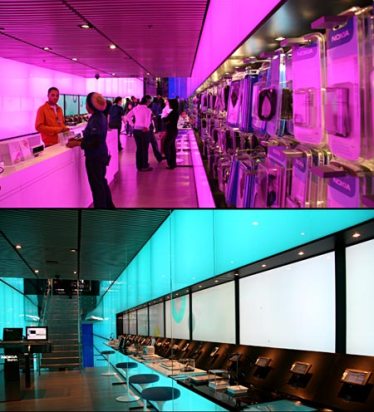 Microsoft announces “Surface“. Click the link. Better seen than described.
Microsoft announces “Surface“. Click the link. Better seen than described.
v
f
<Via Scobleizer>
 As promised, here’s my take on the Nokia store on 57th street, Manhattan. First off, while the Apple store around the corner is a futuristic, the Nokia store makes it look like the Little House on the Prairie. The building’s peacock-blue facade, one of the few parts of the store you cannot interface with, seems to be made out of gigantic plastic pieces from an educational toy. With neighbors like Bulgari, Burberry, Louis Vuitton, Prada and Tiffany, the flagship store appears to be less about actual retailing and more about exposure. Click here for more photos.
As promised, here’s my take on the Nokia store on 57th street, Manhattan. First off, while the Apple store around the corner is a futuristic, the Nokia store makes it look like the Little House on the Prairie. The building’s peacock-blue facade, one of the few parts of the store you cannot interface with, seems to be made out of gigantic plastic pieces from an educational toy. With neighbors like Bulgari, Burberry, Louis Vuitton, Prada and Tiffany, the flagship store appears to be less about actual retailing and more about exposure. Click here for more photos.
Inside the narrow, three-level, two-thousand-square-foot space, luminescent Plexiglas walls and Barry White-inflected music make you feel as if you’d walked into an airport cocktail lounge. Should you wish to change the color of the panels from magenta to cyan or any of the other sixty choices, sit down on a bar stool, pick up one of the cell phones attached to the counters that flank the room, and send a text message to the wall. You can also click to control the images on screens, to switch, say, bubbling bubbles to alphabet letters blowing in the wind. Or you can send a note to the walls in any of the other five Nokia stores in the world. You can also walk upstairs, snap a picture of yourself with the superb optics built into the N93 phone, and print a copy of it to take home (note to Samsung….).
Those entertaining panels actually serve a purpose in that as you pick up any phone, a window pops up with all the details about the phone. A fantastic demonstration of what great digital signage design can be. Here’s a video taken in the store that shows some of the experience:
The first floor contains the main collection of devices, while the second floor holds the NSeries and the tiny third floor is reserved for the exclusive Vertu boutique ($4,500 – $150,000; for a phone, service plan is extra). The second floor resembles the first, with digital panels and high interactivity. Vertu is a jewelry store experience; all phones are under glass and and must be shown to you.
I visited about 15 retail destinations on my recent trip. While the Apple store was the one where people were most actively engaged (duh), for me, it was the Nokia store that offered the experience that made me want to know more about their products. It was an “entertainment experience” that was totally engaging.
(Photos courtesy of newyorkdailyphoto)

While most of the tech bloggers were going gaga last week over Apple’s announcement of new iPod devices and wondering when the iPhone is going to debut, a few guys with much more insight than me were writing about the real stories behind the “iTV” headline.
I highly recommend both of these outstanding posts.
Carl Howe over at Blackfriars’ Marketing writes a great commentary predicting Apple’s entry in the flat panel TV market. Lots of big boxers like Home Depot and Office Depot are announcing their entry into this rapidly growing market, following robust profit reports from Circuit City and Best Buy. While the success of these Johnnies-come-lately is dubious, Howe makes a great case for Apple’s winning in the TV business.
Apple has design icon Jonathan Ive (among many other great designers), one of the best and most powerful brands in the world, incredible differentiation, and is repeatedly ranked number one for product support. It has a chain of 161 stores that generate 67% of the revenue of Best Buy with 10% of the floor space. And most importantly, Apple sells experiences, not low-priced hardware. They’ll offer two or three choices to avoid the tyranny of too much — and amaze everyone again by making more profits on fewer products.
Over at the Mac Observer, John Martellaro’s take on the “iTV” story is that Apple’s strategy:
The result, Martellaro predicts, is that Apple has a strong chance of owning the game in home video entertainment.
Today, the home entertainment industry is confusing. Customers muddle through. Some dare to ask questions; some just plug it all in and hope things work. Issues linger: Is my 1080i HDTV already obsolete? What is HDCP, HDMI, de-interlacing, scaling, 802.11n? Should I go with cable or satellite? Will Blu-ray finally win? No one company has stood up, with courage, and said: “We have a vision. This is how to do it. Follow us.”
Now, Apple is starting to provide that leadership in home theater. They’re defining an architecture, putting the product pieces into place, and developing leading edge products.
But most importantly, Apple is inserting this orchestrated scheme of pre-planned and well defined technology into a massive technology consumption machine fueled by the consensus thinking on the Internet. If it sucks, it’s history. If it’s cool, it’ll be embraced, and any company that tries to force the issue against this massive thinking machine will fail.
The platform dubbed “iTV” will be revolutionary. Apple has demonstrated the ability to bring simplicity to complicated things and they appear to be poised to do it again for home theater. What’s more, iTV will bring video iChat and the internet to the living room. When they introduce a flat panel display, you can bet it will have an “iSight” camera built into the top bezel just as their computers do now. iChat, along with inevitable higher bandwidth connections could revolutionize home-based communications and the “internet from the sofa” will certainly bring increased impulse buying online, including of course, movies and more from Apple’s iTunes store.
 Phillips has always been an innovator in lighting and displays. Now they bring that innovative approach to the lowly T-shirt with their Lumalive light emiting textiles. Phillips is currently targeting promotional companies, “looking for new, high-impact media.” Hopefully, the technology will remain costly enough to keep it out of the mainstream novelty T-shirt channel as the visual noise could be overwhelming.
Phillips has always been an innovator in lighting and displays. Now they bring that innovative approach to the lowly T-shirt with their Lumalive light emiting textiles. Phillips is currently targeting promotional companies, “looking for new, high-impact media.” Hopefully, the technology will remain costly enough to keep it out of the mainstream novelty T-shirt channel as the visual noise could be overwhelming.
While the textile innovation is interesting, I think the bigger story is that Phillips has discovered YouTube as a great medium for sharing their innovation work. I had heard about this technology, but it wasn’t until I saw the video that I had an appreciation for what it could do. Have half a million people opted in to learn about your company’s innovations?
Here’s the link to the YouTube LumaLive video.
Here’s a link to more Phillips YouTube demonstrations.

"Electronic home attendant Cleopatra is a digital avatar that appears on screens and wireless tablets throughout ElectronicHouse's 2006 Home of the Year. She greets each resident in the home by name, announces visitors, phone calls, voice mails, emails and deliveries. Cleopatra shows who is home, pictures of recent visitors at the front door, the local weather forecast, stock market changes, and even the national security level."
But wait there's more…… For a look at the near future in Digital Home Services, read the entire story here and be sure to look at all the photos to appreciate the amount of technology in this house

People love tiny gadgets like the iPod or Motorola Q. But they don't like staring at tiny screens, especially now that handhelds have the power to run 3-D games and display television-quality video.
An interesting article from Wired gives us a view into the near future where tiny, laser-based projectors could transform these pocket-size devices into full-blown entertainment systems by shining images onto walls, tabletops or the backs of airplane seats.
Read the whole story here: Wired Article